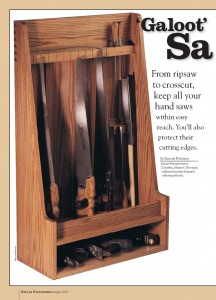We may receive a commission when you use our affiliate links. However, this does not impact our recommendations.
 In the Saw Storage chapter for “Handsaw Essentials,” I would have liked to include this sawtill that Samuel Peterson built; it was featured in the August 2000 issue of Popular Woodworking.
In the Saw Storage chapter for “Handsaw Essentials,” I would have liked to include this sawtill that Samuel Peterson built; it was featured in the August 2000 issue of Popular Woodworking.
Alas, the files are so old that I would have had to send out slides for scans and rekey the text. And I guess I’m just not that committed. Also, I ran out of pages. So instead, I offer here a download of the scanned pages, free.
Click below to download:
GalootSawtill
Here are some supplies and tools we find essential in our everyday work around the shop. We may receive a commission from sales referred by our links; however, we have carefully selected these products for their usefulness and quality.








http://s212.photobucket.com/user/gangl1/library/Saw%20Till
Here is the link to a couple of saw tills that I designed and built. The bigger one is more of a traditional till for hand saws and larger back saws complete with a small drawer for files, coping saw blades, and my flush cut saw. The other is more of a cabinet designed to hold dovetail saws, small carcass saws, and my keyhole saw. Hopefully the link works, if not you may need to copy and paste.
The problem with that saw till is that the dovetails joining the upper back stretcher (C) to the sides (A) are totally dysfunctional. Basically, they’re zippers. With a small amount of stress, the tails all break off at their bases, because the grain is going in the wrong direction. I asked Chris about it, and he acknowledged that the till had been destroyed in shipment because those joints failed. A mortise and tenon, or even a sliding dovetail would be more appropriate, and might be further strengthened with another mortise and tenon joining the Large Kerf Board (H) to the sides, assuming the last kerf on each end is not too deep and not too close to the sides.
The dovetail error still makes this project a good lesson in joinery. Perhaps an even better way to fix it would be to turn the upper back stretcher board (C) horizontal, and cut normal case dovetails in the ends of the top and sides. There’s less clearance for removing and replacing saws, but it still works as a saw till. You may want to use two boards, one horizontal on top and one vertical on the back, glued long grain, so you have something structural to which to attach a French cleat. There are other design considerations for using a French cleat, however. Check with Bob Lang; the new till he’s building for the upcoming article uses one.
Now I understand. You’re using this as a “lead in” to build interest in Bob’s upcoming article, right?
There is another thing about the Galoot till that bothers me. The shelf underneath is insufficient for holding the number of planes that someone with that many hand saws would be expected to own and use. OK, Bob’s new design solves that problem too.
One more thought: For a very good example of appropriate joinery, you need go no further than the traditional Shaker step stool. The top stretchers are joined to the sides with a half pin and half tail, and the top step is dovetailed to the sides.
http://bit.ly/1ePFA6D